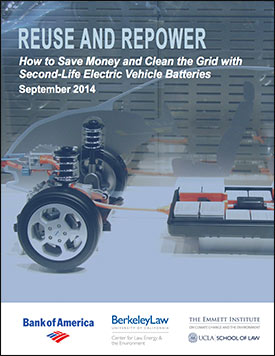
By Andrew Cohen
As California searches for cheap energy storage, a new report by Berkeley and UCLA law schools suggests that used electric car batteries may be an ideal solution.
“Most batteries will retain much of their capacity and value after the use of the car,” said report author Ethan Elkind, associate director of the climate change and business program at Berkeley Law’s Center for Law, Energy & the Environment (CLEE) and the UCLA School of Law. “As a result, repurposing them can absorb excess renewable energy and dispatch it when the sun isn’t shining and the wind isn’t blowing.”
According to the report “Reuse and Repower: How to Save Money and Clean the Grid with Second-Life Electric Vehicle Batteries,” used electric car batteries can help California achieve its renewable energy, greenhouse gas reduction and energy storage goals more efficiently — and lower the cost of owning an electric car.
“Electric cars and their batteries can benefit the electric grid in several ways,” said Steven Weissman, director of CLEE’s energy program. “First, vehicle owners can be encouraged to charge at night to help smooth out the demand for power. Second, in-car batteries can provide active storage capacity that offers a modest amount of power back to the grid when needed. Finally, a large number of used batteries can be aggregated to become a storage bank managed by the grid operators. Each of these practices would help reduce the cost of buying an electric car.”
Although California is experiencing a surge in renewable energy generation from the sun and wind, the state will face long-term economic and environmental challenges relying on these intermittent resources without deploying more energy storage.

Large-scale energy storage technologies can capture surplus renewable energy during times of low demand for later use, the report finds. The report also describes how second-life batteries could provide businesses and homes with backup power—while saving owners electricity costs.
“Utilities can stack reused batteries to store excess power during times of heavy demand, which would provide substantial savings and reduce the need for costly fossil fuel-burning power plants,” Elkind said. “Large business entities such as a hospital or university can use the batteries as bulk energy storage when the power goes out and the grid is prone to fail, or to offset high-expense energy stretches. Property owners can use repackaged individual batteries for backup power or to go off the grid entirely.”
California accounts for more than 40 percent of electric vehicle sales in the United States, and experts conservatively project that roughly half of the battery packs can be repurposed with 75 percent of their original capacity.
The aggregated capacity of these batteries would provide nearly one-third of the energy storage capacity that utilities are required to procure by 2020 under a recent California mandate. Second-life batteries projected to be on the road by 2025 in California alone could store and dispatch enough electricity to power 4.5 million households in any given moment—the equivalent of almost 10 percent of the state’s installed power capacity, according to Elkind.
More storage, more savings
The report notes that second-life batteries could reduce upfront electric vehicle costs. Studies indicate, for example, that a used Nissan LEAF battery could net the car owner approximately $2,000 in resale value.
Private companies and research institutions have launched pilot electric car battery storage programs—aggregating used batteries to develop a commercial-scale energy storage system and a “microgrid” backup system, among other uses.
“These efforts have reached various stages and we’re still building and assessing the data,” Elkind said. “That’s one of the report’s major recommendations, to support these projects and share data across all sectors, because that will help build the market.”

The report captures the conclusions reached by a group of automakers, utility representatives, energy storage developers, business leaders, and public officials who met in Los Angeles in April at a gathering sponsored by Berkeley Law and UCLA Law. The report is the 13th in a series produced by the Climate Change and Business Research Initiative, funded by Bank of America.
The group identified key barriers to developing a second-life battery market: uncertainty about battery value translating to lower upfront car buying costs; complex and adverse regulations that limit market opportunities; liability concerns about which entity is responsible for the batteries after their vehicle use; and a lack of data about battery performance.
To surmount those obstacles, the report urges expanded second-life battery pilot projects to demonstrate market potential, increased funding for data collection and dissemination, a working group to address regulatory conflicts, and—to clarify product liability—industry-developed technical performance standards for battery certification.
“Liability concerns discourage people from using these batteries in different ways, but car parts are reused all the time and we’ve figured out who has liability—and when,” Elkind said. “Energy storage developers also have a tough field to navigate, given the highly regulated world of utilities that they’re trying to enter, but that’s why these pilot programs are vital. The more certainty there is about potential revenue and how reused electric car batteries will perform, the more incentive there will be for private investment.”